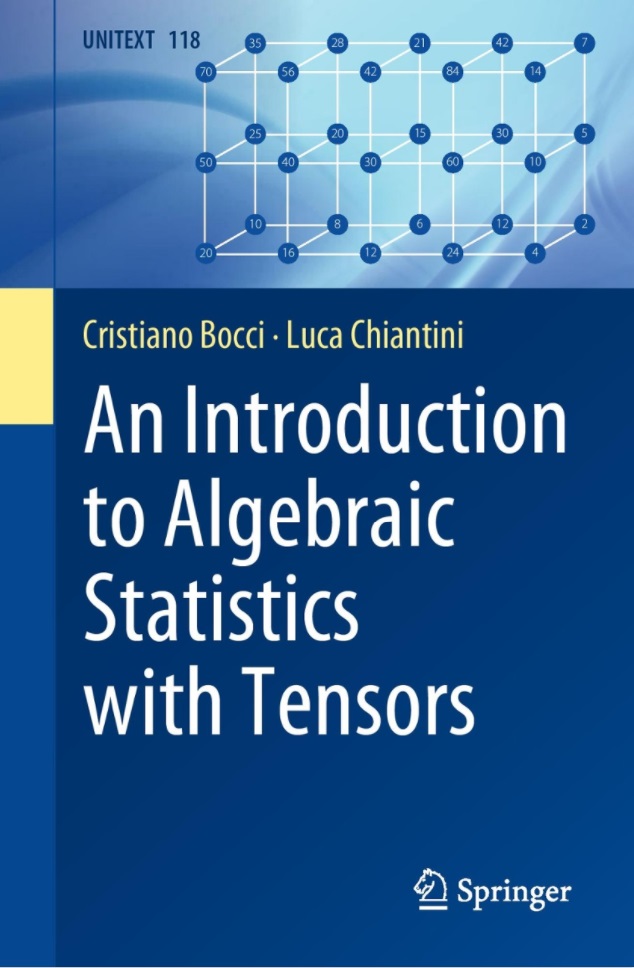Algebraic Statistics - Class Notes
From An Introduction to Algebraic Statistics with Tensors, by Christiano Bocci and Luca Chiantini (Spring, 2019)

Copies of the classnotes are on the internet in PDF format as given below. The notes and supplements may contain hyperlinks to posted webpages; the links appear in red fonts. The "Proofs of Theorems" files were prepared in Beamer. The "Printout of Proofs" are printable PDF files of the Beamer slides without the pauses. These notes have not been classroom tested and may have typographical errors.
"Algebraic Statistics" is not a formal class at ETSU. These notes are meant for self-study.
Suggested background for this material includes Mathematical Statistics 1 (STAT 4047/5047), Theory of Matrices (MATH 5090), and Applied Multivariate Statistical Analysis (STAT 5730).
Preface.
Part I. Algebraic Statistics
Chapter 1. Systems of Random Variables and Distributions.
Chapter 2. Basic Statistics.
- 2.1. Basic Probability.
- 2.2. Booleanization and Logic Connector.
- 2.3. Independence Connections and Marginalization.
- 2.4. Exercises.
- Study Guide 2.
Chapter 3. Statistical Methods.
- 3.1. Models.
- 3.2. Independence Models.
- 3.3. Connections and Parametric Models.
- 3.4. Rotic Models and Exponential Matrices.
- Study Guide 3.
Chapter 4. Complex Projective Algebraic Statistics.
- 4.1. Motivation.
- 4.2. Projective Algebraic Models.
- 4.3. Parametric Models.
- Study Guide 4.
Chapter 5. Conditional Independence.
- 5.1. Models of Conditional Independence.
- 5.2. Markov Chains and Trees.
- 5.3. Hidden Variables.
- Study Guide 5.
Part II. Multi-linear Statistics
Chapter 6. Tensors.
- 6.1. Basic Definitions.
- 6.2. The Tensor Product.
- 6.3. Rank of Tensors.
- 6.4. Tensors of Rank 1.
- 6.5. Exercises.
- Study Guide 6.
Chapter 7. Symmetric Tensors.
- 7.1. Generalities and Examples.
- 7.2. The Rank of a Symmetric Tensor.
- 7.3. Symmetric Tensors and Polynomials.
- 7.4. The Complexity of Polynomials.
- 7.5. Exercises.
- Study Guide 7.
Chapter 8. Marginalization and Flattening.
- 8.1. Marginalization.
- 8.2. Contractions.
- 8.3. Scan and Flattening.
- 8.4. Exercises.
- Study Guide 8.
Part III. Commutative Algebra and Algebraic Geometry
Chapter 9. Elements of Projective Algebrac Geometry.
- 9.1. Projective Varieties.
- 9.1.1. Associated Ideals.
- 9.1.2. Topological Properties of Projective Varieties.
- 9.2. Multiprojective Varieties.
- 9.3. Projective and Multiprojective Maps.
- 9.4. Exercises.
- Study Guide 9.
Chapter 10. Elements of Projective Algebrac Geometry.
- 10.1. Linear Maps and Change of Coordinates.
- 10.2. Elimination Theory.
- 10.3. Forgetting a Variable.
- 10.4. Linear Projectie and Multiporjective Maps.
- 10.5. The Veronese Map and the Segre Map.
- 10.6. The Chow's Theorem.
- 10.7. Exercises.
- Study Guide 10.
Chapter 11. Dimension Theory.
- 11.1. Complements on Irreducible Varieties.
- 11.2. Dimension.
- 11.3. General Maps.
- 11.4. Exercises.
- Study Guide 11.
Chapter 12. Secant Varieties.
- 12.1. Definitions.
- 12.2. Methods for Identifiability.
- 12.2.1. Tangent Spaces and The Rerracini's Lemma.
- 12.2.2. Inverse Systems.
- 12.3. Exercises.
- Study Guide 12.
Chapter 13. Groebner Bases.
- 13.1. Monomial Orderings.
- 13.2. Monomial Ideals.
- 13.3. Groebner Basis.
- 13.4. Buchberger's Algorithm.
- 13.5. Groebner's Bases and Elimination Theory.
- 13.6. Exercises.
- Study Guide 13.
Return to Bob Gardner's home page

